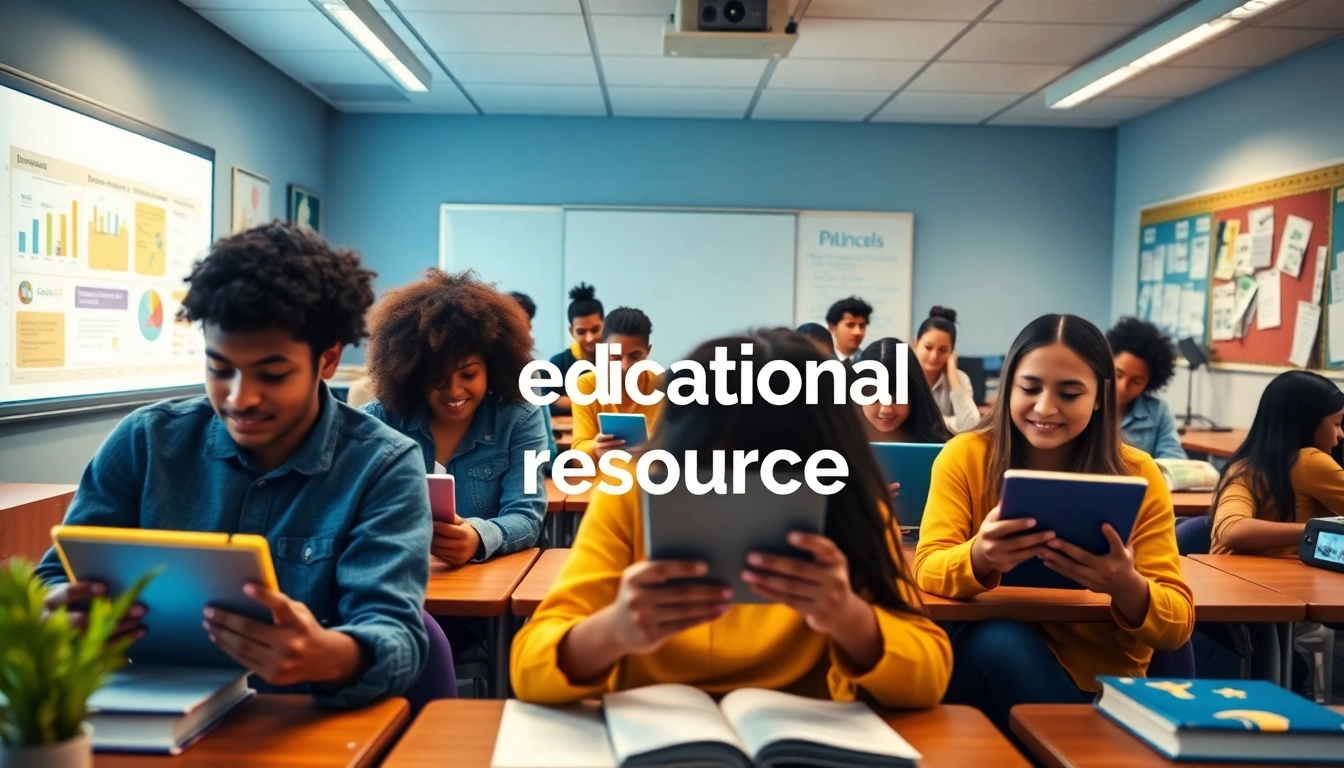Understanding Educational Resources
In today’s rapidly changing educational landscape, educational resources have become essential tools for effective learning and teaching. These resources encompass a wide range of materials and tools designed to support learners and educators alike. The drive towards open access and the democratization of education has made educational resources more available than ever, allowing for greater participation and collaboration across various demographics.
What Are Educational Resources?
Educational resources refer to a variety of materials used to facilitate learning. They can include textbooks, digital platforms, worksheets, videos, simulations, and other tools that contribute to the learning process. As the field of education evolves, the definition of educational resources has broadened to include digital content known as Open Educational Resources (OER), which are available free of charge and are openly licensed.
These resources can be categorized into several types:
- Text-based materials: These include textbooks, articles, and other written content that provide instructional information.
- Multimedia: Videos, podcasts, and interactive simulations that cater to different learning styles.
- Assessment tools: Quizzes, tests, and other evaluation materials to assess learning progress.
- Online platforms: Websites and applications designed to facilitate learning in virtual environments.
The Importance of Accessibility in Education
Accessibility is a critical aspect of educational resources. The ability of learners to access high-quality materials can significantly influence their educational outcomes. Limitations in access often lead to educational disparities, particularly for those in underserved communities. By providing accessible educational resources, we ensure that all learners have the opportunity to succeed.
Recent initiatives, such as the promotion of OER, aim to improve accessibility. OER are designed to be freely available, allowing educators and students to access high-quality materials without financial barriers. In addition, these resources often come with flexible licensing options, empowering users to adapt and modify content to suit their unique needs.
Types of Educational Resources Available
Understanding the types of educational resources is crucial for both educators and students to make informed choices. Here are some of the major categories:
- Open Educational Resources (OER): These are high-quality teaching, learning, and research materials that are available in the public domain or released under a license that allows free use and repurposing.
- Professional Development Materials: Resources aimed at improving educators’ teaching skills, including webinars, workshops, and training programs.
- Assistive Technology Tools: Technological software or devices that help students with disabilities access and engage with educational content.
- Curricular Materials: Comprehensive plans or frameworks designed for specific subjects or grade levels.
Benefits of Utilizing Educational Resources
The use of educational resources provides a multitude of benefits that can enhance the learning experience for students and improve teaching methodologies for educators.
Enhancing Learning Experiences
Utilizing educational resources can dramatically enhance the learning experience. By integrating multimedia content, such as videos or interactive simulations, educators can cater to diverse learning preferences and engage students more effectively. Active learning strategies, where students interact with the material, allow for deeper understanding and retention of concepts.
Improving Teaching Techniques
For educators, educational resources serve as invaluable tools for improving instruction. Access to up-to-date materials and teaching strategies empowers teachers to design and deliver engaging lessons. Additionally, resources such as lesson plans, instructional videos, and classroom management tools can help educators refine their techniques and approach to teaching.
Facilitating Collaborative Learning
Educational resources promote a culture of collaboration among students. With tools like discussion boards, group projects, and online platforms, students can work together and learn from each other. This collaborative environment fosters critical thinking, communication skills, and teamwork, all of which are essential for success in today’s workforce.
How to Choose the Right Educational Resources
Choosing the right educational resources can be challenging due to the sheer volume available. Here are some strategies to streamline the selection process:
Identifying User Needs and Goals
The first step in selecting appropriate educational resources involves understanding the specific needs and goals of the learners or the educational institution. Are the resources aimed at enhancing basic skills, or are they tailored for advanced learning? Identifying these objectives will help educators narrow down their options.
Evaluating Resource Credibility
Resource credibility is paramount when selecting educational content. Check the qualifications of the authors, the review process of the materials, and any applicable endorsements or recognitions by educational institutions. Resources that are peer-reviewed or produced by reputable organizations generally carry more weight.
Balancing Quality and Quantity
While having a broad range of resources can be beneficial, prioritizing quality is essential. Educational resources should be relevant, reliable, and engaging. It is better to have a few high-quality resources than an extensive list of mediocre ones. Reviewing curated lists or recommendations from educational experts can also bolster this process.
Implementing Educational Resources Effectively
Once educational resources have been selected, the next step is implementing them effectively. Here are some strategies to ensure successful integration into learning environments:
Strategies for Teachers and Educators
Educators should not only introduce educational resources but also create an environment that encourages their use. This may involve setting clear expectations, organizing training sessions for students, and providing ongoing support. Using a blended approach where traditional methodologies and modern resources coexist can create a more dynamic learning environment.
Incorporating Technology in Resource Use
Technology plays a crucial role in accessing and utilizing educational resources. Incorporating Learning Management Systems (LMS) or online collaborative tools can enhance student engagement and make content delivery more efficient. Educators should familiarize themselves with available technologies and integrate those that complement the resources being used.
Tracking Progress and Feedback
To assess the effectiveness of educational resources, it is vital to track student progress and gather feedback. Utilizing assessments and surveys can help educators determine what works and what doesn’t. This data allows for continuous improvement, enabling educators to adjust their approaches and resource selections accordingly.
Future Trends in Educational Resources
The landscape of educational resources is constantly evolving. Understanding the trends shaping this field can prepare educators and students for future developments.
The Role of Open Educational Resources (OER)
OER is set to play an increasingly significant role in education. As more institutions and educators recognize the benefits of shared resources, the adoption of OER will likely continue to rise. This trend will promote collaboration and innovation in curriculum development, encouraging educators to create, share, and improve educational materials collaboratively.
Impact of Digital Transformation
The ongoing digital transformation revolutionizes how educational resources are created, shared, and consumed. E-learning platforms, mobile apps, and virtual reality are redefining the educational experience. As technology continues to advance, these innovative approaches will enable more personalized and adaptive learning experiences.
Continuous Learning and Resource Adaptation
Educational resources must evolve as the needs of learners and educators change. Continuous learning will be vital, as both students and educators will need to be adaptable to new tools and methodologies. Professional development opportunities focused on new educational technologies and pedagogies will be essential for maintaining up-to-date knowledge and expertise.



